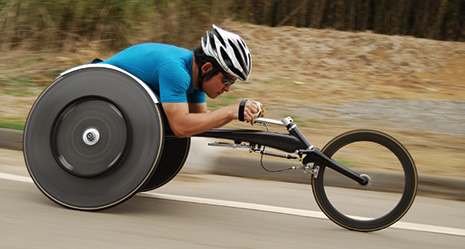Home > Highlighting JAPAN > Highlighting Japan August 2016 > The Summer Olympics: Gold Medal Wisdom from Japan
Highlighting JAPAN


Hot Wheels
Wheelchairs for athletes custom-made by Japan’s OX Engineering Co. are favored by many Paralympians around the world.
Established in 1988, OX Engineering Co. in Chiba City, Chiba Prefecture is a global manufacturer of wheelchairs. The company entered the sports wheelchair business in 1993. Beginning with the 1996 Atlanta Paralympic Games, Japanese and international athletes have won more than seventy medals using the company’s wheelchairs, among them tennis player Shingo Kunieda, who won gold at the 2008 Beijing and 2012 London Paralympics. At the 2012 Games, OX’s wheelchairs were used by more than one fifth of all track and field wheelchair athletes, who won thirteen medals in total.
One of the most important components of a track and field wheelchair is the mainframe, which connects the front and back wheels while also providing support to the athlete.
“A significant amount of force is applied to a wheelchair, because an athlete throws his or her body weight both vertically and horizontally when pushing the rear wheels,” says Tohru Ozawa, the person in charge of the design and production of track and field wheelchairs at OX. “The mainframe needs to be strong but also flexible to endure that power.”
OX has been adopting a variety of configurations and materials through trial and error to develop a robust and flexible mainframe. The company has chiefly used aluminum, but in 2012 it released a track and field wheelchair made of carbon fiber which was both stronger and lighter than conventional models. The carbon fiber mainframe provided better vibration absorption too, thereby reducing athlete fatigue. The development of wheelchairs using carbon fiber intensified after the London Paralympics and it is expected that many more such wheelchairs will be used at the 2016 Rio Games than in the 2012 London Games.
Welding is one of the most sensitive processes in the production of a track and field wheelchair. The heat generated when welding slightly distorts a wheelchair’s frame and so needs to be performed carefully, factoring in the expected distortion. In addition, top class athletes have highly particular requirements that help give them an edge in competition. One foreign track and field athlete stayed in Japan for about a week to create a best-fitting wheelchair by exchanging opinions with Ozawa directly and repeating trial rides at OX.
“Our strength is that we can make wheelchairs that perfectly match athletes’ needs by responding to their specific requests. Over the past fifteen years, I have made more than 1,000 wheelchairs, no two of which are the same,” says Ozawa. “We also focus on how cool a wheelchair looks. An athlete will ride in a wheelchair more confidently if his wheelchair looks cool.”
The production of track and field wheelchairs is not necessarily very profitable because all are custom-made to accommodate athletes’ different disabilities, physiques and muscle strength. Wheelchairs for daily life account for 90% of the wheelchairs produced by OX. However, the knowledge of materials, configurations, and manufacturing techniques built up through the development of sports wheelchairs is being transferred to the development and manufacturing of these wheelchairs for daily life.
Today there is a very high level of competition in the development of sports wheelchairs as advanced technologies are utilized more widely. For example, reducing air resistance is an important challenge in the development of wheelchairs for track and field. In a marathon race, the average speed of a wheelchair, 30 kilometers per hour, may exceed approximately 60 kilometers on a downward slope. Efforts are thus being made to reduce the number of protrusions on the wheelchairs, since these increase air resistance.
“Going forward, we want to find seat positions in which athletes can use their abilities to the fullest, through analysis of their movement and strength. We also want to try to incorporate a greater variety of materials in our wheelchairs,” says Ozawa. “There is still a lot of room for improvement.”
© 2009 Cabinet Office, Government of Japan







